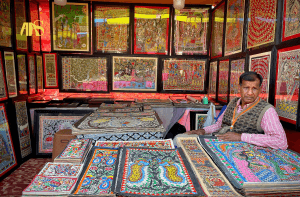Have you ever gazed at a piece of art that doesn’t seem to depict anything recognizable?
That’s likely an abstract painting. Unlike traditional art forms that strive to represent reality, abstract paintings use shapes, colors, and textures to evoke emotions and ideas without relying on literal representation.
Let’s delve into the world of abstract art and explore what makes it so intriguing.
Understanding Abstract Art
Abstract art is a broad term encompassing various styles and techniques that prioritize form, color, and composition over realistic representation.
Instead of depicting objects or scenes, abstract artists focus on expressing emotions, ideas, or experiences through visual elements. This can result in works that are both challenging and rewarding to interpret.
Key Characteristics of Abstract Paintings
- Non-Figurative: Abstract paintings often lack recognizable figures or objects. Instead, they focus on abstract shapes, lines, and colors.
- Emotional Expression: Abstract art is often used to convey emotions and feelings that may be difficult to express through words.
- Experimentation: Abstract artists frequently experiment with new techniques and materials, pushing the boundaries of traditional art forms.
- Subjectivity: The interpretation of abstract art is highly subjective, allowing viewers to find their own meaning within the work.
Famous Abstract Artists and Movements
- Abstract Expressionism: This American art movement, which emerged in the 1940s and 1950s, was characterized by its emphasis on emotion and non-representational forms. Famous abstract expressionists include Jackson Pollock, Mark Rothko, and Willem de Kooning.
- Color Field Painting: This style, popularized by artists like Mark Rothko and Barnett Newman, focuses on large, flat fields of color that evoke emotional responses.
- Geometric Abstraction: Geometric abstract artists use simple shapes, lines, and patterns to create compositions that are often characterized by their balance and symmetry. Famous practitioners include Piet Mondrian, Vasily Kandinsky, and Kasimir Malevich.
The Appeal of Abstract Art
- Emotional Connection: Abstract art can evoke strong emotional responses, allowing viewers to connect with the artist’s intentions on a personal level.
- Intellectual Stimulation: The open-ended nature of abstract art can stimulate intellectual curiosity and encourage critical thinking.
- Aesthetic Appeal: Many abstract paintings are visually striking and can add a unique touch to any space.
- Artistic Freedom: Abstract art offers artists a high degree of creative freedom, allowing them to experiment with new ideas and techniques without constraints.
Additional Information
Abstract art continues to evolve and inspire artists and viewers alike.
Today, contemporary abstract artists are pushing the boundaries of the genre, experimenting with new materials, technologies, and approaches.
Whether you’re a seasoned art collector or simply curious about the world of abstract art, there’s something to discover and appreciate in this fascinating field.
Conclusion
Abstract paintings offer a unique and thought-provoking experience for viewers. By exploring the world of abstract art, you can gain a deeper appreciation for the creativity and diversity of human expression.
So, the next time you encounter an abstract painting, take a moment to immerse yourself in its world and discover the hidden meanings that lie within.





